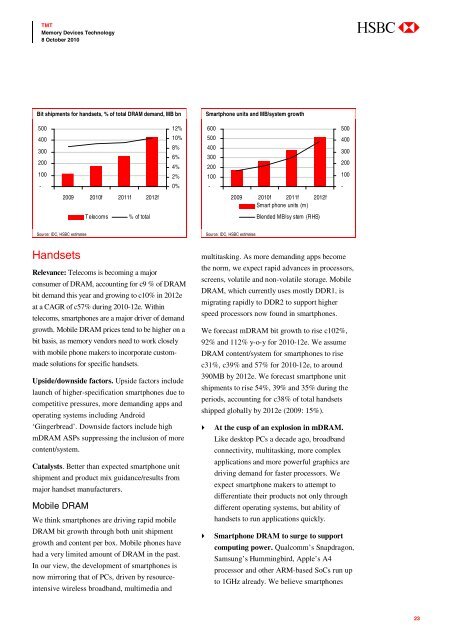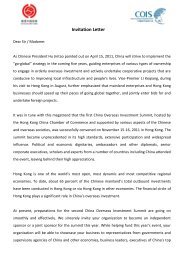You also want an ePaper? Increase the reach of your titles
YUMPU automatically turns print PDFs into web optimized ePapers that Google loves.
TMT<br />
<strong>Memory</strong> Devices Technology<br />
8 October 2010<br />
abc<br />
Bit shipments for handsets, % of total DRAM demand, MB bn<br />
Smartphone units and MB/system growth<br />
500<br />
400<br />
300<br />
200<br />
100<br />
-<br />
12%<br />
10%<br />
8%<br />
6%<br />
4%<br />
2%<br />
0%<br />
600<br />
500<br />
400<br />
300<br />
200<br />
100<br />
-<br />
500<br />
400<br />
300<br />
200<br />
100<br />
-<br />
2009 2010f 2011f 2012f<br />
2009 2010f 2011f 2012f<br />
Smart phone units (m)<br />
Telecoms<br />
% of total<br />
Blended MB/sy stem (RHS)<br />
Source: IDC, HSBC estimates<br />
Source: IDC, HSBC estimates<br />
Handsets<br />
Relevance: Telecoms is becoming a major<br />
consumer of DRAM, accounting for c9 % of DRAM<br />
bit demand this year and growing to c10% in 2012e<br />
at a CAGR of c57% during 2010-12e. Within<br />
telecoms, smartphones are a major driver of demand<br />
growth. Mobile DRAM prices tend to be higher on a<br />
bit basis, as memory vendors need to work closely<br />
with mobile phone makers to incorporate custommade<br />
solutions for specific handsets.<br />
Upside/downside factors. Upside factors include<br />
launch of higher-specification smartphones due to<br />
competitive pressures, more demanding apps and<br />
operating systems including Android<br />
‘Gingerbread’. Downside factors include high<br />
mDRAM ASPs suppressing the inclusion of more<br />
content/system.<br />
Catalysts. Better than expected smartphone unit<br />
shipment and product mix guidance/results from<br />
major handset manufacturers.<br />
Mobile DRAM<br />
We think smartphones are driving rapid mobile<br />
DRAM bit growth through both unit shipment<br />
growth and content per box. Mobile phones have<br />
had a very limited amount of DRAM in the past.<br />
In our view, the development of smartphones is<br />
now mirroring that of PCs, driven by resourceintensive<br />
wireless broadband, multimedia and<br />
multitasking. As more demanding apps become<br />
the norm, we expect rapid advances in processors,<br />
screens, volatile and non-volatile storage. Mobile<br />
DRAM, which currently uses mostly DDR1, is<br />
migrating rapidly to DDR2 to support higher<br />
speed processors now found in smartphones.<br />
We forecast mDRAM bit growth to rise c102%,<br />
92% and 112% y-o-y for 2010-12e. We assume<br />
DRAM content/system for smartphones to rise<br />
c31%, c39% and 57% for 2010-12e, to around<br />
390MB by 2012e. We forecast smartphone unit<br />
shipments to rise 54%, 39% and 35% during the<br />
periods, accounting for c38% of total handsets<br />
shipped globally by 2012e (2009: 15%).<br />
At the cusp of an explosion in mDRAM.<br />
Like desktop PCs a decade ago, broadband<br />
connectivity, multitasking, more complex<br />
applications and more powerful graphics are<br />
driving demand for faster processors. We<br />
expect smartphone makers to attempt to<br />
differentiate their products not only through<br />
different operating systems, but ability of<br />
handsets to run applications quickly.<br />
Smartphone DRAM to surge to support<br />
computing power. Qualcomm’s Snapdragon,<br />
Samsung’s Hummingbird, Apple’s A4<br />
processor and other ARM-based SoCs run up<br />
to 1GHz already. We believe smartphones<br />
23
















